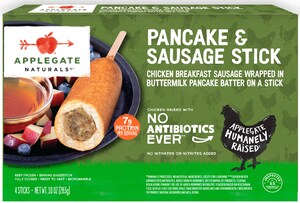Do You Know Where Your Sodium Is Hiding?
Consumers Can Save on Sodium and Still Enjoy Favorite Foods
BRIDGEWATER, N.J., March 17, 2011 /PRNewswire/ -- The recently released 2010 Dietary Guidelines for Americans recommends that Americans consume less than 2,300 milligrams of sodium a day, but with the average American at 3,500 milligrams, how can consumers shake the salt habit? Amy Marlow, MPH, RD, says a few minor changes in food choices can help people stop sodium setbacks.
"One of the biggest problems consumers contend with is the misconception that the salt shaker contributes most to high sodium intake, when in fact it's the hidden sodium in highly-processed foods that pumps sodium levels up," says Marlow. With processed foods, she explains, the best choice isn't always clear unless you read the food label. "Someone may think they're making a good choice by using lean roast beef for their sandwich, but two slices of roast beef from a conventional brand can pack on 760 milligrams of sodium.*"
By comparison, two slices of Applegate Organic Roast Beef, reduces sodium by more than half (320 milligrams per two slices). Applegate is the leading producer of natural and organic meats and cheeses.
"With just a few moderate changes and alternative choices, consumers really can enjoy the foods they love – even hot dogs – and get closer to sodium recommendations," says Marlow. A diet high in sodium can lead to hypertension/high blood pressure, heart disease and kidney failure.
Slashing Sodium
- Eat at home: Restaurant and store-bought prepared foods tend to have significantly more sodium than meals you make at home.
- Go natural: Whether it's packaged crackers or meat, natural and organic varieties tend to have less sodium, and in the case of meat, no hormones or antibiotics. For example, hot dogs can be packed with sodium and fat (a leading brand has 550 milligrams of sodium and 16 grams of fat), yet an Applegate Great Organic Beef Hot Dog has 330 milligrams of sodium and 8 grams of fat.*
- Turn lemons into taste aid: Adding a splash of lemon or lime juice to foods can add zing and zest without salt.
- Spice it up: Experiment with fresh and dried herbs and spices to add flavor to your favorite dishes without added salt.
- Can the cans: Go for frozen vegetables instead of canned, which often have high sodium levels in the canning solution. If you prefer canned veggies, check for no salt added varieties.
- Make your foundation whole: Base most of your diet on whole and minimally processed foods like whole grains, fruits, vegetables, beans, legumes, nuts, and low fat dairy products. If these foods make up the bulk of your diet, the occasional higher-sodium processed or restaurant-prepared food will not stop you from reaching your sodium intake goals.
"Reducing sodium doesn't have to mean eating bland food or giving up your favorites," says Marlow. "Read food labels to help you make healthy choices at the store, and cook with high-quality whole foods, allowing your ingredients' natural flavors to shine through."
*Based on comparison of available nutrition information of two leading brands by certified registered dietitian.
About Applegate
For more than 20 years, Applegate has been producing high-quality natural and organic hot dogs, bacon, sausages, deli meats, cheese and frozen products. Natural can mean many things, but when Applegate says their products are natural, consumers are guaranteed that the meat inside is:
- Raised without antibiotics or hormones
- From animals fed a vegetarian or 100% grass diet and treated with humane animal standards
- Free of added chemical nitrites, nitrates or phosphates
- Free of artificial ingredients or preservatives
For more information about our products, visit www.applegatefarms.com
SOURCE Applegate
WANT YOUR COMPANY'S NEWS FEATURED ON PRNEWSWIRE.COM?
Newsrooms &
Influencers
Digital Media
Outlets
Journalists
Opted In




Share this article